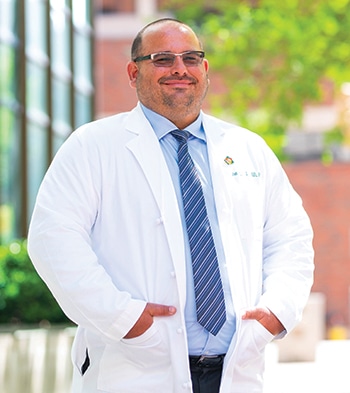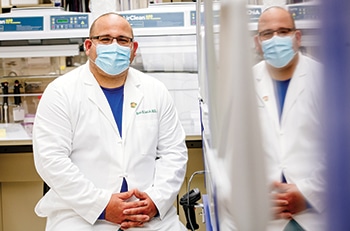Karen Titus
June 2023—A bad-news, good-news, bad-news, good-news bass line thrums through the ongoing story of Candida auris as it continues to spread in the United States.
Initially identified in Japan, in 2009, in an ear specimen—hence the auris—the yeast was first reported in the United States in 2016.
Like certain other pathogens, C. auris’ domestic presence appeared to be linked to travel-related cases, then quickly spread, first to the metropolitan regions of Chicago and New York City and now to more than half the states.
That’s worrisome. Yet the spread hasn’t been unbridled. Early fears that it would sweep indiscriminately through all patient populations have not been realized.
“It’s not as virulent as albicans,” says Sixto M. Leal Jr., MD, PhD, director of the clinical microbiology laboratory and of the fungal reference laboratory, University of Alabama at Birmingham, and a member of the CAP Microbiology Committee. “It’s about as virulent as Candida glabrata. It’s not too much of a significant threat if you’re healthy.”
For patients with multiple comorbidities, however, the impact can be severe. This would include those in ICUs or in long-term care facilities, and patients who are connected to IV or urinary catheters, or who are ventilated, says Dr. Leal, who is also director of UAB’s regional biocontainment laboratory and associate professor in the Department of Pathology. Those who are getting sick from Candida auris often have multiple comorbidities and a high likelihood of prior exposure to antibacterial agents, he says, allowing room for nonbacteria to colonize and expand their population, providing a niche for the growth of C. auris.
When Candida auris was found to be multidrug resistant, MRSA-tinged fears soon followed. Those concerns remain, but not every C. auris clade has turned out to be pan-resistant. And though breakpoints for commonly used antifungals are not available—and are likely to remain elusive—other options have emerged.
Finally, C. auris remains difficult to identify using traditional biochemical methods. But in recent years MALDI-TOF has become a reasonable option for many labs, and it’s a fast, straightforward way to identify the organism.
Even those who felt prepared for the arrival of Candida auris found their first case jarring.Erin McElvania, PhD, D(ABMM), recalls the first case at the Chicago-area NorthShore University HealthSystem, in 2017. From the literature, “We knew of its existence,” says Dr. McElvania, director of clinical microbiology. It was a shock nevertheless. “There it is. Your jaw just drops.” It felt even more dire at the time, she says, given the unknowns and unsettling predictions.
Loyola University Medical Center also belonged to that early hotspot, identifying its first isolate in 2017, says Amanda Harrington, PhD, D(ABMM), director of the clinical microbiology laboratory and professor, Department of Pathology and Laboratory Medicine. “I hear people say, Oh, this is our first isolate. We’re well past that, unfortunately.”

Dr. Sixto M. Leal Jr. at the University of Alabama at Birmingham. “There is a lot of interest in generating breakpoints for Candida auris,” says Dr. Leal, an advisor to the CLSI antifungal susceptibility testing subcommittee and a member of the CAP Microbiology Committee. [Photo: Brian Pride]
Dr. Harrington minces no words. “It’s very, very tenacious and that makes it a threat. In the right patient at the right time, especially if it’s in an invasive site, it can be very detrimental clinically.”
Dr. McElvania echoes concerns about the organism’s spread. Studies done in long-term care settings show extremely high rates of colonization, she says. “So when they enter the hospital there’s a good chance they’re going to bring it with them.” Infection control oversight at these facilities may not match that at hospitals, making them a vector for hospital spread.
“Until we can control it in those settings, we won’t ever be able to eradicate it,” she cautions. “I feel like it’s gone too far already.”
Perhaps the biggest—and most hopeful change in recent years is that even as the spread of Candida auris is worsening, it’s also becoming easier for more labs to identify it.Because Candida auris was such a pressing matter, manufacturers (BioMérieux, Bruker) made it a priority to update their databases—which are now FDA-approved—for the organism, says Dr. Leal. Moreover, MALDI-TOF itself, long a rich lab’s game, is now within reach of many labs, he says. “Once it was added to FDA-claimed databases, labs with MALDI-TOF MS started identifying C. auris readily,” he adds. “It’s just as straightforward to identify as Candida albicans—not hard at all.”
His own lab had been using the updated FDA-claimed MALDI-TOF database for about a year prior to identifying UAB’s first case, he says. “So I don’t think C. auris was hanging out and we were just missing it,” he says. The lab did identify one haemulonii, which was assessed by sequencing to see if it might be Candida auris. It wasn’t. “So I do think we caught the first auris that came through, and we caught it easily because of the MALDI-TOF system we have.”

At UAB, where case numbers are still relatively low, every time a Candida auris case is identified, the lab does susceptibility testing. “And then we sit down with infection prevention and key folks from antimicrobial stewardship, and we talk about the isolate and tentative breakpoints,” Dr. Leal says. [Photo: UAB News/Steve Wood]
Without MALDI-TOF, the lab may identify it as haemulonii. “That’s what gives you the initial concern that it might be auris,” he says. “If in-house culture or molecular assays are not available, you’ll then need to send it to a state lab or reference lab for definitive identification.”
That could cause lengthy delays. State laboratories that see a large number of cases and have a specific, high level of interest in C. auris will have faster turnaround times than states with lower volumes, Dr. Leal says. In Alabama, the turnaround time is typically five to seven days for results. “Fortunately, we have the MALDI.”
For labs that do need to send out specimens for confirmation, Dr. Harrington suggests a possible intermediate strategy: A potential case identified on chromogenic media could be identified as “presumptive” until the final identification is confirmed. Whatever strategy labs use will require good coordination and communication between the lab and the infection prevention team as to what those results mean, she says.
Institutions are using several types of strategies to address both surveillance and clinical testing needs.NorthShore University HealthSystem developed a screening protocol for high-risk patients shortly after identifying its first C. auris isolate. “It’s not very labor-intensive or difficult,” says Dr. McElvania. Swabs are collected from the skin—nares, axilla, groin—and cultured on basic fungal media. Any yeast that’s grown is identified by MALDI-TOF. (“We validated our instrument before FDA approval was sought, so we still use our research-use-only database,” she notes.)
Currently the CDC does not recommend screening patients for Candida auris when they are admitted to the hospital, which makes sense, observers say, given that costs would be high and yield would be low.
“If you did want to establish screening,” says Dr. Leal, “the way to do it is either by culture or PCR.” Though companies are working on rapid commercial C. auris PCR tests, for now most institutions that perform this assay use a laboratory-developed test.
Dr. McElvania doesn’t see much need for a point-of-care test. (“Though faster is always more fun,” she concedes.) “We don’t do universal screening, but we know it’s circulating in our area.”
She and her NorthShore colleagues have not found an automated way to use Epic to identify patients who need to be screened, as happens with MRSA. They are mainly concerned about high-risk hospitalized patients—typically from long-term care facilities who are ventilated or have a tracheostomy. She praises the close and flexible relationship between the lab and the infection control group. “Right now we don’t have any what I would call stringent infection control screening protocols, but we have regular meetings with them, and our infection preventionists do look for those patients manually and request they be screened for Candida auris.”
They also continue to talk about whether and how testing should be expanded to other patient groups. “There’s no slam dunk,” she says. Oftentimes information about where the patient is coming from is essentially free-texted into the electronic health record so the data cannot be pulled and identified easily.
The other end of the process is also conversation-heavy, Dr. McElvania reports. When a positive case shows up, “there’s a lot of activity around screening patients who may have been in contact with the case patient, isolation, and cleaning procedures.
“So a lot of flurry on the front end and the back end,” Dr. McElvania continues. “But for us, the lab part is straightforward.” Plates are incubated for five days and read for organism growth twice during that period—at 48 hours and five days. Though it would be nice to perform testing at a somewhat faster pace, she acknowledges, the elevated cost would not be worth it, given the hospitals’ low rates of Candida auris.
It does show up on routine blood, urine, and respiratory cultures. For the first quarter of 2023, the lab identified eight different clinical cases, Dr. McElvania says. “That’s a little higher than we typically see. Every quarter we get a handful, usually in the one to four range. It’s still rare enough to us that whenever we get one, it’s, Whoa!”
Loyola has also maintained its culture-based surveillance strategy, in no small part because of the onslaught of demands placed on the lab during the pandemic, says Dr. Harrington.
The lab uses a chromogenic media, which is helpful, Dr. Harrington says, because C. auris is not the same color as Candida albicans (which is more common in many of their colonization sites). “So we can weed that out very quickly, and you’re not missing this bug in a mixed population.” It’s not particularly challenging to grow, she adds, though “culture is a little slow for cultivation, so we hold it for a couple days to make sure we’ve grown the organism.”
Loyola uses two types of surveillance. One, which Dr. Harrington describes as a passive strategy, involves more extensive searching beyond typical clinical testing strategies, she says. For sites like urine or respiratory, where yeast may not be clinically significant, “we’re going to go ahead and identify if there’s a Candida auris there, as sort of a broader, safety-net strategy. We just don’t want a colonizing strain, even if it’s not clinically invasive. That’s an approach we’ve taken from a very early standpoint.”
The active surveillance strategy calls for patients in the designated risk groups to have samples from axilla/groin swabs sent to the lab for culture. This is done primarily using CHROMagar. If an organism consistent with Candida auris is identified, it’s sent to MALDI-TOF for a full identification.
Echoing others, she says MALDI-TOF makes identification fairly easy. “The labs that don’t use MALDI are the ones that really need to understand where the pitfalls are,” says Dr. Harrington. “We still know that our old biochemical methods may or may not be able to accurately identify this organism.”
 CAP TODAY Pathology/Laboratory Medicine/Laboratory Management
CAP TODAY Pathology/Laboratory Medicine/Laboratory Management
